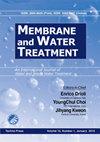Removal of Pb(II) from wastewater by biosorptionusing powdered waste sludge
IF 1.1
4区 工程技术
Q4 ENGINEERING, CHEMICAL
引用次数: 0
Abstract
Lead is a highly toxic heavy metal that causes serious health problems. Nonetheless, it is increasingly being used for industrial applications and is often discharged into the environment without adequate purification. In this study, Pb(II) was removed by powdered waste sludge (PWS) based on the biosorption mechanism. Different PWSs were collected from a submerged moving media intermittent aeration reactor (SMMIAR) and modified Ludzack-Ettinger (MLE) processes. The contents of extracellular polymeric substances were similar, but the surface area of MLE-PWS (2.07 m2/g) was higher than that of SMMIAR-PWS (0.82 m2/g); this is expected to be the main parameter determining Pb(II) biosorption capacity. The Bacillaceae family was dominant in both PWSs and may serve as the major responsible bacterial group for Pb(II) biosorption. Pb(II) biosorption using PWS was evaluated for reaction time, salinity effect, and isotherm equilibrium. For all experiments, MLE-PWS showed higher removal efficiency. At a fixed initial Pb(II) concentration of 20 mg/L and a reaction time of 180 minutes, the biosorption capacities (qe) for SMMIAR- and MLE-PWSs were 2.86 and 3.07 mg/g, respectively. Pb(II) biosorption using PWS was rapid; over 80% of the maximum biosorption capacity was achieved within 10 minutes. Interestingly, MLE-PWS showed enhanced Pb(II) biosorption with salinity values of up to 30 g NaCl/L. Linear regression of the Freundlich isotherm revealed high regression coefficients (R2 > 0.968). The fundamental Pb(II) biosorption capacity, represented by the KF value, was consistently higher for MLE-PWS than SMMIAR-PWS.粉末状废污泥生物吸附去除废水中的铅(II)
铅是一种剧毒的重金属,会导致严重的健康问题。尽管如此,它越来越多地用于工业应用,并且经常未经充分净化就排放到环境中。在本研究中,粉末状废污泥(PWS)基于生物吸附机制去除Pb(II)。采用浸没式移动介质间歇曝气反应器(SMMIAR)和改进的Ludzack-Ettinger (MLE)工艺收集不同的PWSs。细胞外高分子物质含量相似,但MLE-PWS的比表面积(2.07 m2/g)高于SMMIAR-PWS (0.82 m2/g);这有望成为决定铅(II)生物吸附能力的主要参数。芽孢杆菌科在两种pss中均占主导地位,可能是铅(II)生物吸附的主要菌群。对PWS吸附Pb(II)的反应时间、盐度效应和等温平衡进行了评价。在所有实验中,MLE-PWS表现出更高的去除效率。在初始Pb(II)浓度为20 mg/L、反应时间为180 min的条件下,SMMIAR-和MLE-PWSs的生物吸附量分别为2.86和3.07 mg/g。PWS对Pb(II)的生物吸附速度快;在10分钟内达到最大生物吸附量的80%以上。有趣的是,当盐度高达30 g NaCl/L时,MLE-PWS对Pb(II)的生物吸附能力增强。Freundlich等温线线性回归显示回归系数高(R2 > 0.968)。以KF值为代表的基本Pb(II)生物吸附能力,MLE-PWS始终高于SMMIAR-PWS。
本文章由计算机程序翻译,如有差异,请以英文原文为准。
求助全文
约1分钟内获得全文
求助全文
来源期刊

Membrane Water Treatment
ENGINEERING, CHEMICAL-WATER RESOURCES
CiteScore
1.90
自引率
30.00%
发文量
0
审稿时长
>12 weeks
期刊介绍:
The Membrane and Water Treatment(MWT), An International Journal, aims at opening an access to the valuable source of technical information and providing an excellent publication channel for the global community of researchers in Membrane and Water Treatment related area. Specific emphasis of the journal may include but not limited to; the engineering and scientific aspects of understanding the basic mechanisms and applying membranes for water and waste water treatment, such as transport phenomena, surface characteristics, fouling, scaling, desalination, membrane bioreactors, water reuse, and system optimization.
 求助内容:
求助内容: 应助结果提醒方式:
应助结果提醒方式:


